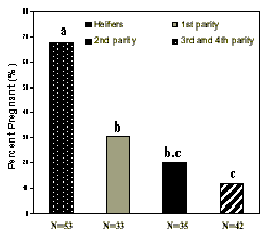Anusha Balendran, Jeff Nimmo, Nelson Dinn, and Raja Rajamahendran
Fertility has become a major problem for many dairy producers. Researchers in the UK and USA have reported very low pregnancy rates (PR) in high producing dairy cows. Moreover, high incidences of reproductive abnormalities such as cystic ovarian disease, delayed ovulation, and reduced length and/or intensity of behavioural estrus have been observed in high producing cows.
The PR for heifers bred by AI have not markedly changed during the past 50 years. However, reproductive statistics for heifers have not been published recently and would be a valuable tool for assessing changes in PR associated with parity that occur independent of lactation.
Reduced PR have been associated with low, or abnormal progesterone levels after AI. Progesterone is a hormone necessary for uterine function and embryonic development. It also influences maternal recognition of the embryo. The landmark events in progesterone production after AI include the beginning of the luteal phase with the formation of the corpus luteum (CL) and associated initial rise in progesterone levels. This is followed by either the end of the luteal phase (in the case of an unsuccessful AI) with a decline in progesterone production or prolongation of the luteal phase (if the AI is successful and the embryo is recognized) and continued elevated progesterone levels. A positive relationship between progesterone levels at the beginning of the luteal phase and pregnancy has been observed. Progesterone levels at the end of the luteal phase have also been reported as differing between pregnant and non-pregnant cows. Parity’s effect on peripheral progesterone production is as yet unclear.
Therefore, the objectives of this study were to a) compare PR between cows of different parity and heifers and b) describe differences between cow’s and heifer’s progesterone levels as a means of examining reasons for decreased PR with increasing parity.
Beginning in April of 2004, pregnancy rates for 163 Holstein cows and heifers bred at the UBC Dairy Education and Research Centre in Agassiz were recorded. AI services and pregnancy diagnosis results were recorded until at least 30 animals were included in each of four groups; heifers (14 to 16 months), 1st parity, 2nd parity, and 3rd or 4th parity. In addition, the luteal function (progesterone levels) of 10 heifers, and 10 cows in each of three parity groups; 1st parity, 2nd parity and 3rd or 4th parities were assessed. The experimental time period spanned April until mid-September, 2004.
Animals were housed in free stall barns and fed a total mixed ration of corn silage, hay and concentrates. Animals were bred as part of the routine management of the herd, and pregnancy diagnosis was performed around 35 days post AI by ultrasonography. Progesterone levels in blood from heifers and whole milk from cows were measured to assess luteal function among animals.
In total, 11 samples were taken every other day from each animal, from the day of AI (day 0) until 22 days post AI. Blood samples were taken from the tail vein, centrifuged, and the plasma frozen for subsequent progesterone analysis. Milk samples were obtained during milking time in the parlour and frozen for subsequent progesterone analysis.
Pregnancy rate following first insemination was 67.9%, 42.9%, 20.0%, and 11.9% among heifers, and 1st parity, 2nd parity, and 3rd/4th parity cows, respectively (Figure.1). Statistical analysis showed that PR was greater in heifers following first insemination (p

Figure 1. Pregnancy Rates following first insemination. Columns with different superscripts differ significantly (p

Figure 2. Pregnancy Rates Following second insemination. Columns with different superscripts differ significantly (p
Our study clearly demonstrates that parity has a significant effect on PR. Markedly lower PR was observed in animals of higher parity. Progesterone levels were not affected by parity, and therefore are likely not directly involved in the mechanism of parity’s influence on PR. Areas that could be further researched to learn why PR is reduced in animals with higher parity are parity’s effect on egg quality and uterine environment.
This research was conducted at the UBC Dairy Education and Research Centre in Agassiz. Anusha Balendran is a graduate student in Animal Science at UBC. Jeff Nimmo was a NSERC undergraduate summer student in Dr. Rajamahendran’s lab. Nelson Dinn is the Manager of the Dairy Centre in Agassiz and, Dr. Raja Rajamahendran is a Professor of Animal Science at UBC.
